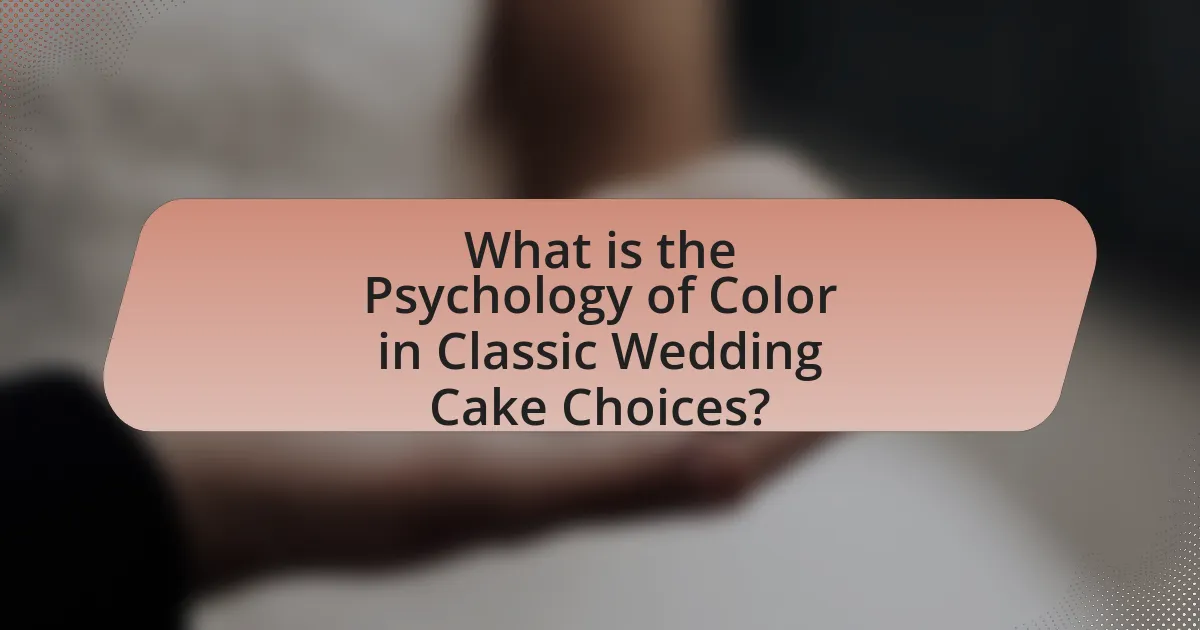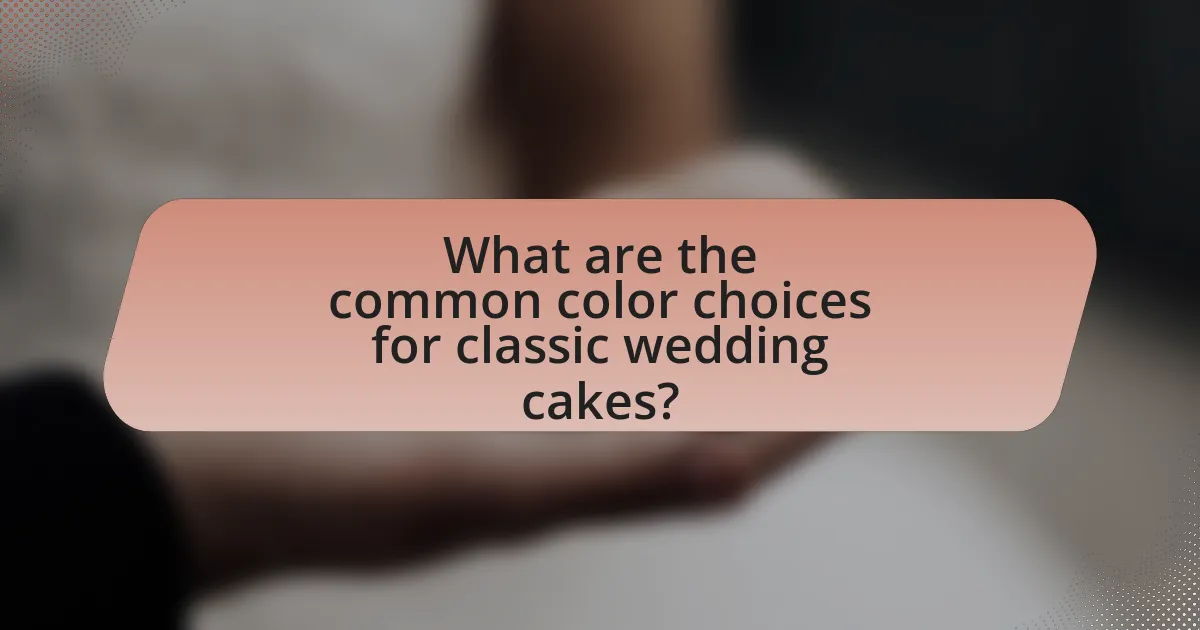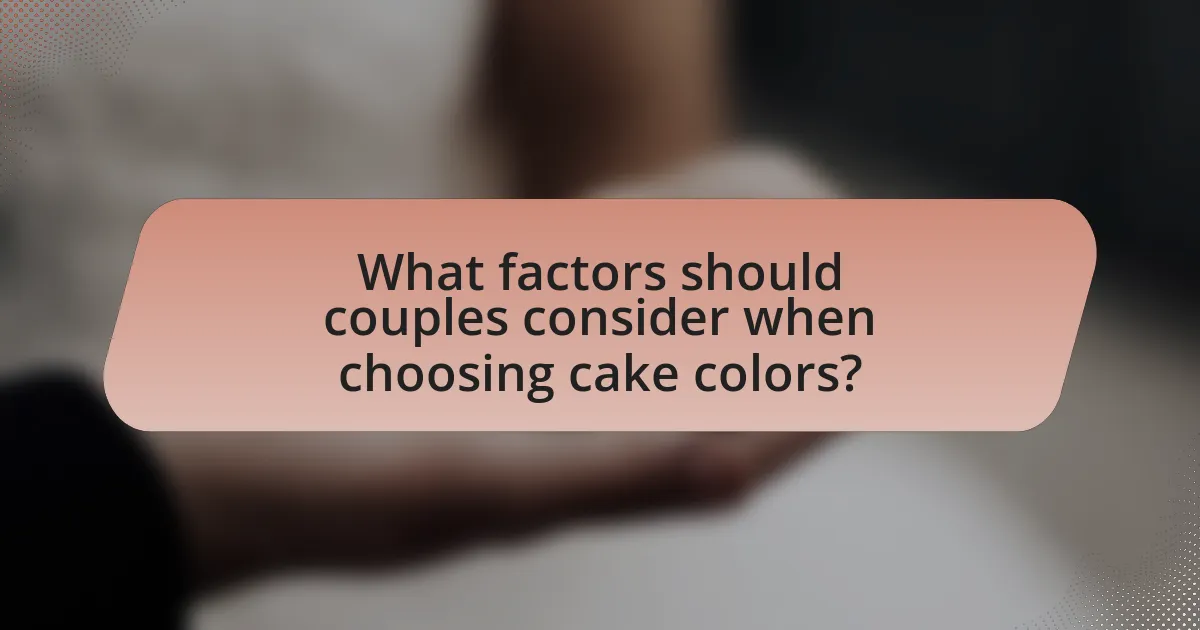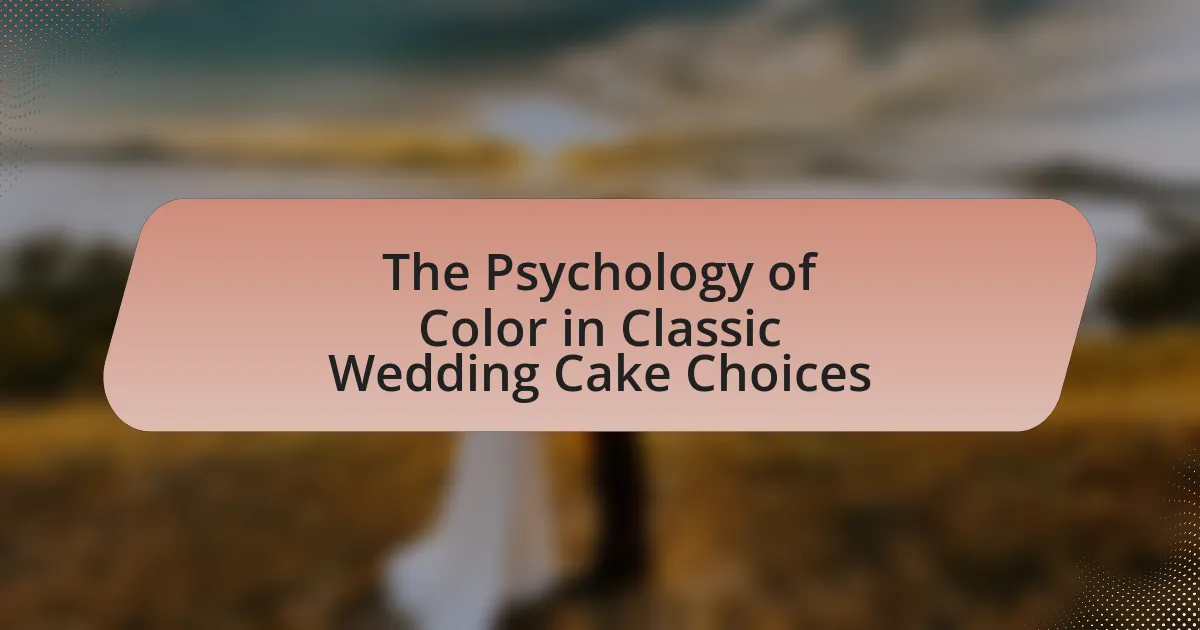The article explores the psychology of color in classic wedding cake choices, highlighting how color influences emotions and perceptions for couples and their guests. It discusses the significance of various colors, such as white for purity and red for passion, and how these choices reflect the couple’s personality and relationship. Additionally, the article examines the impact of color on the overall wedding theme, guest enjoyment, and cultural differences, while providing insights into current trends and best practices for selecting harmonious color palettes. Factors such as seasonal influences and the wedding venue are also considered in the context of cake color selection.

What is the Psychology of Color in Classic Wedding Cake Choices?
The psychology of color in classic wedding cake choices significantly influences the emotions and perceptions of the couple and their guests. Different colors evoke specific feelings; for example, white symbolizes purity and innocence, making it a traditional choice for weddings. Research indicates that colors like red can evoke passion and love, while blue is often associated with calmness and stability. A study published in the Journal of Consumer Research by Andrew J. Elliot and Markus A. Maier highlights how color can affect mood and decision-making, reinforcing the idea that the color of a wedding cake can impact the overall atmosphere of the celebration. Thus, the selection of cake colors is not merely aesthetic but deeply rooted in psychological implications that resonate with the themes of love and commitment.
How do colors influence emotions and perceptions in wedding cake design?
Colors significantly influence emotions and perceptions in wedding cake design by evoking specific feelings and associations. For instance, white symbolizes purity and innocence, often chosen for traditional weddings, while soft pastels like pink and lavender convey romance and tenderness. Research indicates that colors can trigger emotional responses; for example, studies show that warm colors like red and orange can create feelings of excitement and passion, while cool colors like blue and green promote calmness and tranquility. This psychological impact of color is crucial in wedding cake design, as it helps couples express their personalities and the atmosphere they wish to create on their special day.
What psychological effects do specific colors have on individuals?
Specific colors can evoke distinct psychological effects on individuals, influencing emotions and behaviors. For example, red often stimulates feelings of excitement and passion, while blue tends to promote calmness and tranquility. Research indicates that yellow can enhance mood and creativity, whereas green is associated with balance and harmony. A study published in the journal “Color Research and Application” by researchers Andrew Elliot and Markus Maier found that colors can significantly affect cognitive performance and emotional responses, demonstrating the profound impact of color on human psychology.
How can color choices reflect the couple’s personality and relationship?
Color choices can reflect a couple’s personality and relationship by symbolizing their values, emotions, and shared experiences. For instance, vibrant colors like red may indicate passion and excitement, while softer hues like pastels can suggest a more gentle and nurturing bond. Research in color psychology shows that colors evoke specific emotional responses; for example, blue is often associated with calmness and trust, which can mirror a couple’s stable relationship. Additionally, couples may choose colors that represent significant moments in their relationship, such as the color of their first date or a favorite vacation spot, further personalizing their cake design. This intentional selection of colors not only enhances the aesthetic appeal of the wedding cake but also serves as a visual narrative of the couple’s journey together.
Why is color selection important in wedding cake choices?
Color selection is important in wedding cake choices because it influences the overall aesthetic and emotional impact of the wedding. The colors chosen for the cake can reflect the couple’s personality, theme, and mood of the event, creating a cohesive visual experience. For instance, studies in color psychology indicate that colors evoke specific emotions; for example, white symbolizes purity and elegance, while red can signify love and passion. Therefore, selecting the right colors not only enhances the cake’s visual appeal but also reinforces the wedding’s emotional narrative, making it a significant aspect of the celebration.
How does color impact the overall theme and aesthetic of a wedding?
Color significantly impacts the overall theme and aesthetic of a wedding by influencing emotions, setting the mood, and creating visual harmony. Different colors evoke specific feelings; for instance, soft pastels often convey romance and tranquility, while bold hues can express vibrancy and excitement. The choice of color palette can unify various elements of the wedding, such as floral arrangements, attire, and decor, ensuring a cohesive look that aligns with the couple’s vision. Research indicates that color psychology plays a crucial role in decision-making and emotional responses, which is why selecting a color scheme that resonates with the couple’s personality and the desired atmosphere is essential for a memorable wedding experience.
What role does color play in guest perception and enjoyment?
Color significantly influences guest perception and enjoyment by evoking emotions and setting the mood. Research indicates that colors can trigger specific psychological responses; for instance, warm colors like red and orange can create feelings of excitement and warmth, while cool colors like blue and green often promote calmness and relaxation. A study published in the journal “Color Research and Application” by researchers Andrew Elliot and Markus Maier found that color can affect not only mood but also the perceived taste and quality of food, including desserts like wedding cakes. This suggests that the color of a wedding cake can enhance guests’ overall experience, making it more enjoyable and memorable.

What are the common color choices for classic wedding cakes?
Common color choices for classic wedding cakes include white, ivory, pastel shades, and soft metallics. White and ivory symbolize purity and elegance, making them the most traditional options for wedding cakes. Pastel colors like blush pink, lavender, and mint green are popular for their romantic and soft aesthetic, appealing to couples seeking a delicate look. Soft metallics, such as gold and silver, add a touch of sophistication and luxury, often used in accents or decorations. These color choices are rooted in cultural symbolism and aesthetic preferences, reflecting the significance of the wedding celebration.
Which colors are traditionally associated with weddings and why?
White is traditionally associated with weddings because it symbolizes purity and innocence. This association dates back to the 19th century when Queen Victoria wore a white gown for her wedding to Prince Albert in 1840, setting a trend that continues today. Other colors like red are also significant, particularly in cultures such as Chinese, where red symbolizes good fortune and happiness. These color choices reflect cultural values and beliefs surrounding marriage, influencing the aesthetics of wedding celebrations.
What meanings do popular wedding colors convey?
Popular wedding colors convey specific meanings that influence the overall atmosphere and emotional tone of the event. For instance, white symbolizes purity and innocence, often associated with traditional weddings. Red conveys love and passion, making it a popular choice for romantic themes. Blue represents tranquility and loyalty, suggesting a calm and stable relationship. Pink signifies romance and sweetness, appealing to a softer aesthetic. Green embodies growth and harmony, reflecting a fresh start in marriage. Yellow symbolizes joy and optimism, adding a cheerful vibe to the celebration. These associations are rooted in cultural traditions and psychological interpretations of color, which can significantly impact the wedding experience.
How do cultural differences influence color choices in wedding cakes?
Cultural differences significantly influence color choices in wedding cakes, as various cultures attribute distinct meanings and symbolism to colors. For instance, in Western cultures, white is traditionally associated with purity and new beginnings, leading to its prevalence in wedding cakes. Conversely, in many Asian cultures, red symbolizes good fortune and happiness, prompting couples to choose red or gold hues for their wedding cakes. This variation in color preference is supported by cultural customs and beliefs, such as the Chinese tradition of using red for celebrations, which reflects the importance of color in conveying emotions and cultural values during significant life events.
How do trends affect color choices in wedding cakes?
Trends significantly influence color choices in wedding cakes by dictating popular palettes that reflect current aesthetics and cultural preferences. For instance, the rise of pastel colors in recent years aligns with broader trends in wedding decor, where soft hues are favored for their romantic and elegant appeal. Additionally, seasonal trends, such as the popularity of earthy tones in fall weddings, further shape color selections, as couples often seek to harmonize their cake with the overall theme of their event. This influence is supported by data from wedding industry reports, which indicate that color trends can shift annually, impacting consumer choices and baker offerings.
What are the current popular color trends in wedding cakes?
Current popular color trends in wedding cakes include soft pastels, bold jewel tones, and earthy neutrals. Soft pastels like blush pink, lavender, and mint green evoke a romantic and delicate atmosphere, making them a favorite for modern weddings. Bold jewel tones such as emerald green, sapphire blue, and deep burgundy add a touch of luxury and sophistication, appealing to couples looking for a dramatic statement. Earthy neutrals, including taupe, beige, and sage, reflect a natural aesthetic, aligning with the growing trend of rustic and outdoor weddings. These color choices are influenced by seasonal palettes and the desire for personalization in wedding themes, as evidenced by recent surveys indicating that 70% of couples prioritize color coordination in their wedding planning.
How do seasonal changes influence color preferences for wedding cakes?
Seasonal changes significantly influence color preferences for wedding cakes, as couples often choose colors that reflect the mood and aesthetics of the season. For instance, spring weddings typically feature pastel colors like soft pinks and light blues, aligning with the blooming flowers and fresh greenery of the season. In contrast, summer weddings may favor vibrant colors such as bright yellows and bold reds, which evoke the warmth and energy of summer.
Autumn weddings often see rich, warm tones like deep oranges, burgundies, and golds, mirroring the changing leaves and harvest themes. Winter weddings frequently incorporate cooler colors such as icy blues and whites, reflecting the snowy landscapes and holiday themes. This alignment of cake colors with seasonal palettes is supported by studies in color psychology, which indicate that colors can evoke specific emotions and associations tied to different times of the year.

What factors should couples consider when choosing cake colors?
Couples should consider the emotional impact of colors, the wedding theme, and personal preferences when choosing cake colors. The psychology of color suggests that different hues evoke specific feelings; for example, blue can convey calmness, while red may symbolize passion. Additionally, aligning cake colors with the overall wedding theme enhances visual coherence, making the event more aesthetically pleasing. Personal preferences, including favorite colors or cultural significance, also play a crucial role in the decision-making process, ensuring the cake reflects the couple’s identity and values.
How do personal preferences shape color choices for wedding cakes?
Personal preferences significantly influence color choices for wedding cakes, as individuals often select colors that reflect their personalities, cultural backgrounds, and emotional connections. For instance, a bride who favors pastel hues may choose soft pinks or blues to convey a sense of romance and tranquility, while another couple might opt for bold colors like red or gold to symbolize passion and celebration. Research indicates that color can evoke specific emotions; for example, blue is often associated with calmness, while yellow can represent happiness. This psychological impact of color leads couples to make choices that resonate with their personal experiences and aspirations for their wedding day.
What role does the wedding venue play in color selection?
The wedding venue significantly influences color selection by establishing the overall aesthetic and ambiance of the event. The venue’s architecture, decor, and natural surroundings dictate which colors will harmonize or clash with the setting. For instance, a rustic barn may inspire earthy tones, while a beach venue might lead to a palette of soft blues and whites. Studies in color psychology indicate that colors can evoke specific emotions and set the mood; thus, aligning the cake colors with the venue enhances the cohesive experience for guests.
How can the season of the wedding affect color decisions?
The season of the wedding significantly influences color decisions by aligning with seasonal palettes that evoke specific emotions and themes. For instance, spring weddings often feature pastel colors like soft pinks and light greens, which symbolize renewal and freshness, while summer weddings may incorporate vibrant hues such as bright yellows and blues that reflect warmth and joy. In contrast, autumn weddings typically embrace rich, warm tones like deep reds and oranges, representing harvest and change, whereas winter weddings often utilize cool colors like icy blues and whites, evoking a sense of tranquility and elegance. This seasonal alignment not only enhances the aesthetic appeal of the wedding cake but also resonates with the emotional undertones associated with each time of year, making color choices more impactful and meaningful.
What are some tips for harmonizing cake colors with wedding themes?
To harmonize cake colors with wedding themes, select colors that reflect the overall palette of the wedding. For instance, if the wedding theme features soft pastels, a cake adorned in light pinks, blues, or creams will complement the decor. Additionally, consider the season; warm tones like gold and burgundy work well for fall weddings, while bright colors like yellow and turquoise suit summer events. Research indicates that color psychology influences emotions; thus, aligning cake colors with the wedding’s emotional tone can enhance the overall experience. For example, blue is often associated with calmness, making it suitable for serene themes.
How can couples effectively coordinate cake colors with floral arrangements?
Couples can effectively coordinate cake colors with floral arrangements by selecting a color palette that complements both elements. This involves choosing colors that either match or harmonize, such as using analogous colors (colors next to each other on the color wheel) or contrasting colors for visual interest. For instance, if the floral arrangements feature soft pastels, a cake in a similar pastel shade will create a cohesive look. Research indicates that color harmony can enhance aesthetic appeal, as seen in studies on color theory, which suggest that complementary colors can evoke positive emotional responses. Therefore, aligning the cake colors with the floral arrangements not only enhances visual unity but also contributes to the overall emotional atmosphere of the wedding.
What are the best practices for ensuring color consistency across wedding elements?
To ensure color consistency across wedding elements, it is essential to create a cohesive color palette that is applied uniformly across all components, including invitations, decorations, and the wedding cake. Start by selecting a primary color and a few complementary colors, and use these consistently in all design elements. Utilizing color swatches or samples can help maintain accuracy when coordinating with vendors, as colors can appear differently in various materials and lighting. Additionally, digital tools like color matching apps can assist in verifying that colors align across different items. Research indicates that consistent color usage enhances visual harmony and can evoke specific emotional responses, reinforcing the overall theme of the wedding.
What are the common mistakes to avoid in wedding cake color selection?
Common mistakes to avoid in wedding cake color selection include failing to consider the overall wedding theme, neglecting the venue’s color palette, and not accounting for seasonal colors. Choosing colors that clash with the wedding decor can create visual dissonance, while ignoring the venue’s hues may lead to a cake that feels out of place. Additionally, seasonal colors can enhance the cake’s appeal; for example, pastel shades are often favored in spring, while rich, deep colors suit fall weddings. By aligning the cake colors with these elements, couples can ensure a cohesive and aesthetically pleasing presentation.
How can poor color choices impact the overall wedding experience?
Poor color choices can significantly detract from the overall wedding experience by creating visual discord and affecting the emotional atmosphere. When colors clash or fail to complement the wedding theme, they can lead to a disjointed aesthetic that distracts guests and diminishes the celebratory mood. Research indicates that colors evoke specific emotions; for instance, blue is often associated with calmness, while red can evoke excitement. If the chosen colors do not align with the desired emotional tone of the event, it can result in guests feeling uncomfortable or disengaged. Additionally, poor color choices can impact photography, as certain colors may not photograph well, leading to disappointing memories captured in images.
What strategies can couples use to avoid clashing colors?
Couples can avoid clashing colors by utilizing a color wheel to identify complementary colors, ensuring that their chosen palette harmonizes visually. This strategy is effective because complementary colors, which are opposite each other on the color wheel, create a balanced and aesthetically pleasing contrast. Additionally, couples can select a limited color palette, typically consisting of three to five colors, to maintain cohesion and prevent overwhelming combinations. Research in color theory supports that limited palettes enhance visual appeal and reduce the likelihood of clashing. Furthermore, couples should consider the context of their wedding theme and venue, as these factors can influence color perception and harmony. By aligning their color choices with the overall aesthetic of the wedding, couples can achieve a unified look that avoids clashing colors.
How can couples ensure their cake color choices reflect their unique style?
Couples can ensure their cake color choices reflect their unique style by selecting colors that resonate with their personal tastes and wedding theme. This involves considering their favorite colors, the overall color palette of the wedding, and the emotions they wish to evoke through their cake. Research indicates that colors can influence perceptions and feelings; for example, blue often conveys calmness, while red can signify passion. By aligning their cake colors with these psychological associations, couples can create a cake that not only looks beautiful but also embodies their individuality and the atmosphere they want to create on their special day.
What resources are available for exploring color palettes for wedding cakes?
Resources for exploring color palettes for wedding cakes include online platforms like Pinterest and Instagram, which showcase a variety of cake designs and color combinations. Additionally, websites such as The Knot and WeddingWire provide curated galleries and articles on trending color schemes for wedding cakes. Color theory tools like Adobe Color and Coolors can help couples visualize and create harmonious color palettes. These resources are widely used in the wedding industry, offering inspiration and practical guidance for selecting colors that evoke specific emotions and themes, aligning with the psychological impact of color in wedding aesthetics.
How can couples work with bakers to achieve their desired color outcomes?
Couples can work with bakers to achieve their desired color outcomes by clearly communicating their vision and preferences regarding color schemes. This collaboration involves discussing specific colors, providing visual references such as color swatches or images, and understanding the baker’s capabilities with food coloring and techniques. For instance, bakers often use gel food coloring, which allows for vibrant and precise color matching, making it essential for couples to specify their desired shades. Additionally, couples should inquire about the baker’s experience with color blending and layering, as these techniques can enhance the overall aesthetic of the cake.
